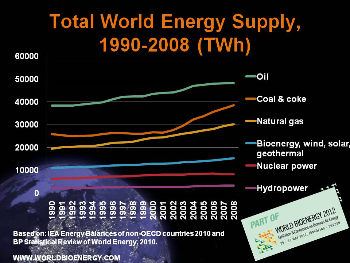 According to data collected by the International Energy Agency, bioenergy utilization has grown to be more than twice that of nuclear. Fossil fuels still account for 81% of world energy use, but bioenergy has grown substantially, particularly in developing regions of the world (Asia, Africa and Latin America).
According to data collected by the International Energy Agency, bioenergy utilization has grown to be more than twice that of nuclear. Fossil fuels still account for 81% of world energy use, but bioenergy has grown substantially, particularly in developing regions of the world (Asia, Africa and Latin America).
(NOTE: Click on graphics to expand them.)
Among renewable technologies, bioenergy dominates followed by hydropower, wind, geothermal and solar. A position paper from the World Bioenergy Association forecasts the bioenergy potential utilization to increase up to 30 times its current use by 2050.
The potential interaction between geosynthetic technologies and bioenergy is great. Geosynthetic tubes, geomembrane covers, floating bags and other materials can provide dependable, well-tested containment and separation solutions.
Exposed geomembranes, for example, have been used with thin-film photovoltaics in solar energy-generating landfill caps. Other applications in which geosynthetics are being used include algal energy farm production, animal waste methane capture/conversion, and wastewater treatment plant (WWTP) solids separation. (Dried sludge, grit, screenings and grease have great energy utilization rates that can power WWTP operations.)
These issues will be explored in detail at World Bioenergy 2012, which will be held 29-31 May 2012 in Jönköping, Sweden.
Abstracts are currently being sought.
 |
 |
Graphics courtesy of World Bioenergy 2012 conference from data collected by the International Energy Agency.
Chris Kelsey is Geosynthetica’s editor, chris@geosynthetica.net.











